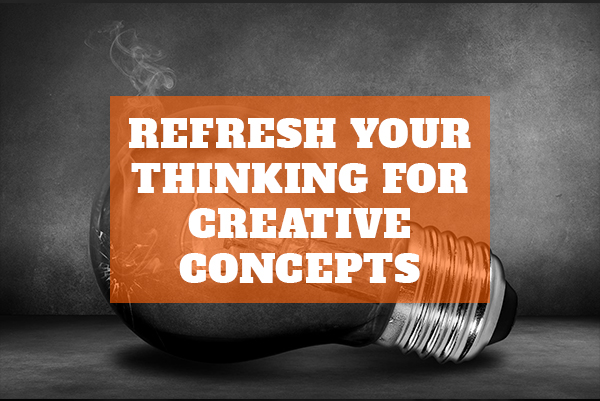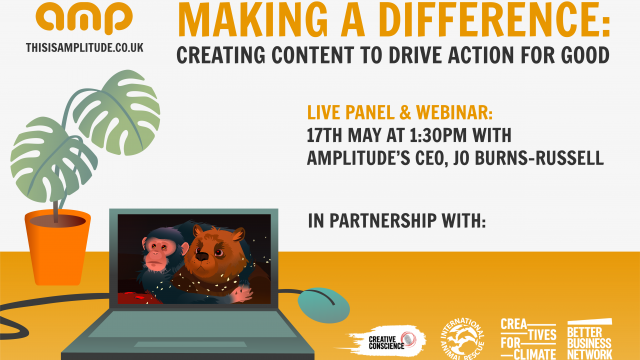Refresh your thinking for creative concepts
This is the second post in our #Innovation series on generating creative concepts. Check out our other posts covering what innovation really means, and how to generate creative concepts.
Refresh Your Thinking
We’ve all been there. You’re on a deadline to write a newsletter, create a video concept, solve a problem, or even design a whole new brand. You need something new, something innovative, but the ideas just aren’t coming. Maybe you’re stuck in loops and everything you think of has been done before. Whatever the problem, we’ve assembled some tips break you out of repetitive ways of thinking into pastures green and new. Many of these came courtesy of the fantastic Lou Palfreyman Consulting, a few are tips of our own. Maybe they’ll work for you too?
Collaboration, Collaboration, Collaboration
Collaboration and innovation often come hand-in-hand. You may be sat there thinking your ideas are stale, but show them to someone else and they’ll come up with a whole host of ideas that build upon your nugget of creativity. Their ideas could change your whole approach to the project, or do just enough to get you around that creative roadblock you’ve been experiencing.
There’s another great reason to collaborate too. Ever heard of being “too close” to a project? That’s what happens when you spend hours, days, weeks, or even months working on the same thing. It becomes your baby. You eat, drink, and breathe it, and, when you’re finally finished, you step back, proud of your perfect achievement… but is it really perfect? Isn’t it possible that you’re “too close” to see its imperfections? (Hint: yes, it’s more than possible). Thankfully, collaboration is a cure for this too. Get some fresh eyes on that project of yours and listen closely to constructive criticism.
Bad Ideas Lead to Good Ideas
It’s not uncommon for people to fall at the very first hurdle: they never get to good ideas because they’re afraid of coming up with bad ideas. But Rome wasn’t built in a day, and neither was Uber, or Spotify, or Facebook.
We celebrate successful innovation every day, but everything hailed as the “next big thing” has a history full of bad ideas and failure. Bad ideas are the mulch that feeds good ideas, they should be celebrated, not feared.
James Dyson developed over 5,000 prototype vacuums before making one that worked; Dyson Ltd was valued at £3.5 billion in 2017. Before launching Huffington Post, one of Arianna Huffington’s books was rejected by 36 publishers; Huffington Post now gets upwards of 120 million visits per month. If at first you don’t succeed, fail more. Every failure is a lesson.
Change Your Vocabulary
When we talk about projects, we tend to use the same words over and over again. It’s often overlooked, but the words we use inform the way we think. Say, for example, you’re looking to create a mascot to promote your toilet paper brand, but every time you try to come up with a new concept your mind drifts back to the Andrex puppy. Sure, it’s cute, but copying them isn’t going to help you establish a unique brand identity.
Try changing the words you’re using. Write out your objective again and again using synonyms or words that are related. For example, try brainstorming using the following three phrases and see how differently you end up thinking:
- Create a lovable mascot to promote your brand
- Design a creature to champion your business
- Conceptualise a cartoon character to make your company image friendlier
All three of these are broadly similar, but the use of different words can take your mind in different directions, leading to different creative concepts. While “lovable” might make you think of that Andrex puppy, “friendly” lead you to choose a creature with a more obvious smile, while “champion” might generate more defiant mascots. It might be that defiance would never work with your brand, but the very act of thinking about it might lead you to a whole host of new creative concepts. Have fun, play with language to see what you come up with.
Vary the Stress Pattern
Along the same kind of lines as the last tip, varying stress in a sentence is a great way to change your thinking. Write out your problem or task, then vary the stressed word to change the meaning. This is an easy way to look at the same issue in a new light. Try the following examples:
“Our employees say our website is hard to read.”
But our customer conversion rates are high. What is it our employees want out of our site that they aren’t getting?
“Our employees say our website is hard to read.”
But internal readership statistics don’t back that up. Maybe we should hold some meetings and dig a bit deeper.
“Our employees say our website is hard to read.”
But they like competitor websites. What is it about those sites that works so well?
“Our employees say our website is hard to read.”
But they love our product brochures that use the same copy, so perhaps we have a layout problem.
“Our employees say our website is hard to read.”
But they love the way it looks. Perhaps we have a problem with our marketing copy?
See how each version of the sentence takes your thinking in a slightly different direction, presenting a different route to possible ideas and solutions? Try it on the sentences below, or give it a go with project you’re working on.
“Our audience wants to see information about our new sale.”
“Millennials think our advice newsletter should look more modern.”
Break Your Habits, Break The Rules
Pattern recognition is important. It’s how we learned to associate roads with danger, and bacon with deliciousness. But there’s a dark side to pattern recognition. Pattern recognition can lead to assumptions getting lodged in your brain that hamper innovation and creativity. Once those assumptions have taken root, it can be pretty damn difficult to dislodge them.
This happens a lot in the business world. We recognise patterns within our industries and subconsciously try to make anything we create fit within those boundaries, but it’s only when people break these patterns that industry advances. As an experiment, grab a piece of paper and write down all the “rules” of your industry. If you’re working on social media posts or newsletters, consider what the industry standards are and ask yourself why it’s important to follow them. If you can’t come up with a good reason to follow the standard, you might have found a great place to innovate.
Consider the mobile phone industry. If we were to write down the “rules” of mobile phone handsets we might end up with a list like this:
- Handsets must make calls
- Handsets must be rectangular
- Handsets must have screens
- Handsets must be mobile
- Handsets must be internet-enabled
Now, every single one of those is pretty integral to the modern idea of a mobile phone, but simply thinking about breaking these rules might lead you to think differently. If not rectangular, what other shape could phones be? If they were a different shape, would people still keep them in pockets and handbags, or would it be more convenient to keep them elsewhere? Could you make them smaller too? If they were smaller, they’d be easier to lose, so maybe add a strap that could go around your wrist… holy moly! You just invented the smart watch!
Unpack The Problem
Nothing exists in a vacuum. Whether you’re aiming to overcome a specific problem or create something new, there are more people involved than just you. There are internal and external stakeholders, you have an audience with interests and experiences, your audience might have their own audience you should consider. If you’re struggling, take a step back and look at the bigger picture.
Map out your network of stakeholders and audiences, everyone that is affected by or impacts upon your business. What effect do you want to have on them? As with the other suggestions on this list, thinking about these other parts of your network might inspire you to new creative concepts.
Do Your Research
The internet is chocked full of useful information and examples of content from other brands. Take a break from looking at your back-catalogue of photos and witty tweets, and instead start looking at what the rest of your industry is doing well. What’s resonating with your target audience? Which brands are they particularly engaged with? What are they doing on their social media channels? Look outside your industry too. What else is your audience into? Build your new ideas on top of what’s already out there, but be sure you’re building and innovating, not copying or just catching up.
Still after more ideas?
Keep an eye out for our next #Innovation blog post with techniques for generating creative ideas. Can’t wait? Amplitude Media’s team includes creatives with all manner of expertise, from video to photography, music to strategy, copywriting to storytelling. Get in touch, and let’s put our heads together to see what we can come up with.








